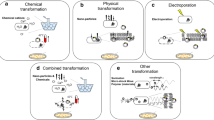Summary
A DNA amplification is correlated with the dominant, unstable cob-354 cobalt resistance trait in the cellular slime mold, Dictyostelium discoideum. The amplified DNA is present as about 50 copies of an extrachromosomal element. Cells grown under nonselective conditions in the absence of cobalt ions lose both the cobalt resistance trait and all extrachromosomal copies of the amplified DNA. The amplified DNA is transferrable to new genetic backgrounds by parasexual genetic crosses. These results explain the inability to map the cob-354 trait to a linkage group. The chromosomal origin of the amplified DNA is group III or VI. Thus the resistance trait appears to be independent of the previously known cobalt resistance locus, cobA, which maps to group VII. A developmental defect involving the production of multiply-tipped aggregates that do not complete fruiting body formation also is correlated with the presence of the amplified DNA.
Similar content being viewed by others
References
Alitalo K, Schwab M (1986) Oncogene amplification in tumor cells. Adv Cancer Res 47:235–281
Cockburn AF, Taylor WC, Firtel RA (1978) Dictyostelium rDNA consists of non-chromosomal palindromic dimers containing 5S and 36S coding regions. Chromosoma 70:19–29
Cole RA, Williams KL (1988) Insertion of transformation vector DNA into different chromosomal sites of Dictyostelium discoideum as determined by pulse field electrophoresis. Nucleic Acids Res 16:4891–4902
Devine JM, Tsang AS, Williams JG (1982) Differential expression of the members of the discoidin I multigene family during growth and development of Dictyostelium discoideum. Cell 28:793–800
Firtel RA, Silan C, Ward TE, Howard P, Metz BA, Nellen W, Jacobson A (1985) Extrachromosomal replication of shuttle vectors in Dictyostelium discoideum. Mol Cell Biol 5:3241–3250
Ford M, Fried M (1986) Large inverted duplications are associated with gene amplification. Cell 45:425–430
Garvey EP, Santi DV (1986) Stable amplified DNA in drug-resistant Leishmania exist as extrachromosomal circles. Science 233:535–540
Goldhagen H, Clarke M (1986) Identification of the single gene for calmodulin in Dictyostelium discoideum. Mol Cell Biol 6:1851–1854
Hamer DH (1986) Metallothionein. Annu Rev Biochem 55:913–951
Hightower RC, Wong ML, Ruiz-Perez L, Santi DV (1987) Electron microscopy of amplified DNA forms in antifolate-resistant Leishmania. J Biol Chem 262:14618–14624
Hyrien O, Debatisse M, Buttin G, de Saint Vincent BR (1988) The multicopy appearance of a large inverted duplication and the sequence at the inversion joint suggest a new model for gene amplification. EMBO J 7:407–417
Metz BA, Ward TE, Welker DL, Williams KL (1983) Identification of an endogenous plasmid in Dictyostelium discoideum. EMBO J 2:515–519
Mouches C, Pasteur N, Berge JB, Hyrien O, Raymond M, de Saint Vincent BR, de Silvestri M, Georghiou GP (1986) Amplification of an esterase gene is responsible for insecticide resistance in California Culex mosquito. Science 233:778–780
Podgorski G, Deering RA (1980) Quantitation of induced mutation in Dictyostelium discoideum. Characterization and use of a methanol-resistance mutation assay. Mutat Res 74:459–468
Poole SJ, Firtel RA (1984) Genomic instability and mobile genetic elements in regions surrounding two discoidin I genes of Dictyostelium discoideum. Mol Cell Biol 4:671–680
Ratner DI, Newell PC (1978) Linkage analysis in Dictyostelium discoideum using multiply marked tester strains: establishment of linkage group VII and the reassessment of earlier linkage data. J Gen Microbiol 109:225–236
Rigby PW, Dieckmann M, Rhodes C, Berg P (1977) Labeling deoxyribonucleic acid to high specific activity in vitro by nick translation with DNA polymerase I. J Mol Biol 113:237–251
Schimke RT (1988) Gene amplification in cultured cells. J Biol Chem 263:5989–5992
Slamon DJ, Godolphin W, Jones LA, Holt JA, Wong SG, Keith DE, Levin WJ, Stuart SG, Udove J, Ullrich A, Press MF (1989) Studies of the HER-2/neu proto-oncogene in human breast and ovarian cancer. Science 244:707–712
Stark GR, Wahl GM (1984) Gene amplification. Annu Rev Biochem 53:447–491
Walton JD, Paquin CE, Kaneko K, Williamson VM (1986) Resistance to antimycin A in yeast by amplification of ADH4 on a linear, 42 kb palindromic plasmid. Cell 46:857–863
Welker DL (1986) Linkage analysis of nystatin resistance mutations in Dictyostelium discoideum. Genetics 113:53–62
Welker DL (1988) The discoidin I gene family of Dictyostelium discoideum is linked to genes regulating its expression. Genetics 119:571–578
Welker DL, Williams KL (1980a) Mitotic arrest and chromosome doubling using thiabendazole, cambendazole, nocodazole and benlate in the slime mould Dictyostelium discoideum. J Gen Microbiol 116:397–407
Welker DL, Williams KL (1980b) The assignment of four new loci, including the coumarin sensitivity locus couA, to linkage group VII of Dictyostelium discoideum. J Gen Microbiol 120:149–159
Welker DL, Hirth KP, Williams KL (1985) Inheritance of extrachromosomal ribosomal DNA during the asexual life cycle of Dictyostelium discoideum: examination by use of DNA polymorphisms. Mol Cell Biol 5:273–280
Welker DL, Hirth KP, Romans P, Noegel A, Firtel RA, Williams KL (1986) The use of restriction fragment length polymorphisms and DNA duplications to study the organization of the actin multigene family in Dictyostelium discoideum. Genetics 112:27–42
Williams KL (1978) Characterization of dominant resistance to cobalt chloride in Dictyostelium discoideum and its use in parasexual genetic analysis. Genetics 90:37–47
Author information
Authors and Affiliations
Additional information
Communicated by G.R. Smith
Rights and permissions
About this article
Cite this article
Jensen, S.L., Ashktorab, H., Hughes, J.E. et al. Gene amplification associated with the dominant cob-354 cobalt resistance trait in Dictyostelium discoideum . Molec. Gen. Genet. 220, 25–32 (1989). https://doi.org/10.1007/BF00260851
Received:
Issue Date:
DOI: https://doi.org/10.1007/BF00260851




